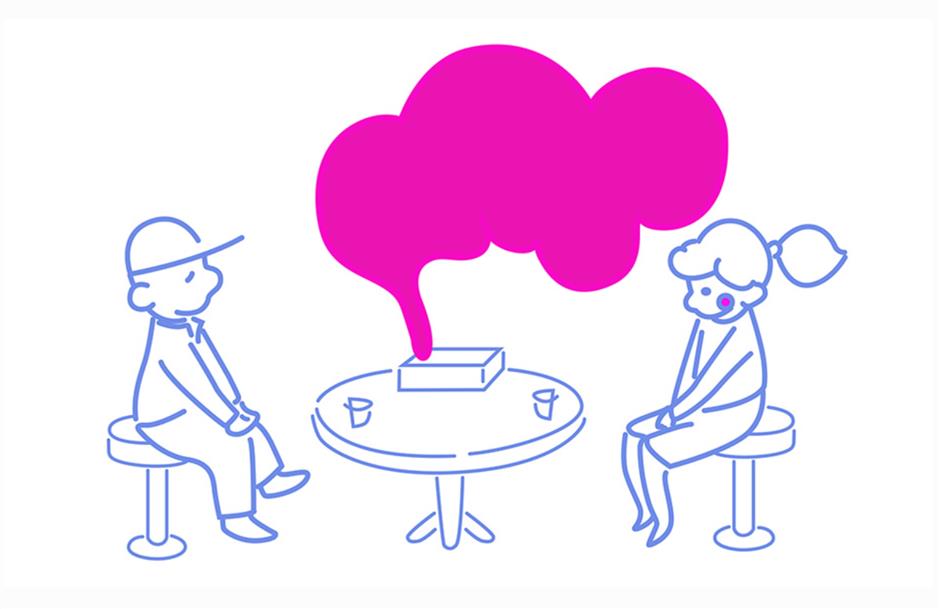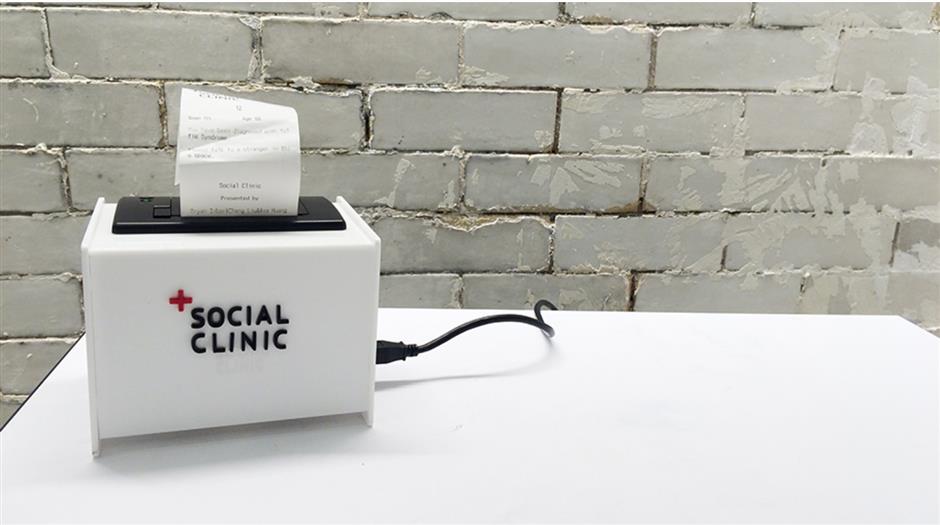Examining human bonds with high-tech art
Podcast EP 9
"Programming, opensource software have opened a new window for designers and artists. It's highly changeable, and it interacts with everything around it, air, humidity, temperature, nature, human. My computer is my work partner," said artist Liu Chang.

Artist Liu Chang (center) and her partners in the Social Clinic project, which was based on data and algorithms, dressed as doctors to help people "diagnose" their social behavioral issues.
Artist Liu Chang feels "obsessed and excited" when she uses data, algorithms, coding and other digital tools to make her artwork and projects, which mainly cover the topics of social interactions, the existence of time and the connection between nature and the artificial world with a sense of humor.
"Programming, opensource software have opened a new window for designers and artists. It's highly changeable, and it interacts with everything around it, air, humidity, temperature, nature, human. My computer is my work partner." Liu has done a lot of interesting and special art projects to seek deeper meanings in interactions, communication and connections.
Art does not serve to treat an illness, but art matters in the process of how it heals us.
Liu Chang
In one of her works, "Scent of Conversation," she uses data and algorithms to create different scents of the chemistry captured between people from their conversations by analyzing their emotions. In another work "Social Clinic," she gives prescriptions like "talk to your loved ones," "say hello and save me from my phone," "talk to me, just do it" in a "Social Clinic" diagnosis.
She believes that art with data and algorithms gives people infinite possibilities, and awakens a higher level of thinking about ourselves and the world around us, especially during tough times like the COVID-19 pandemic.

Illustration of "Scent of conversation"
"When we were at the darkest hour of this world, may it be a song, a painting, or an artistically interactive experience, these things can prompt us to think, to feel, to meditate," Liu said. This is perhaps healing, and the work not only aims to entertain, but also attempts to prompt people to become aware of their anxieties and other social behavioral concerns.
A graduate of Pratt Institute and New York University, Liu's practice ranges from audiovisual and interactive installations to coding art, from digital art to printmaking and artist books. Her work uses algorithms to create new aesthetics in the digital art field.
In the first part of Liu's conversation with Shanghai Daily, she shares with us her ideas about how human beings interact with society around us.
Q: A lot of your projects explore the topic of social interactions. Why?
A: I think it had a lot to do with the fact that our lives revolve around the world of data and social media. For example, there are spaces and personas on Instagram and TikTok made entirely from artificial and fictitious information. There are also cyber celebrities whose profiles are entirely built by nothing real but the Internet, yet these "people" have millions of followers. These kind of Black Mirror-esque changes in our lives have revolutionized the way we socialize and engage with the world, both mentally and physically. Also, when you take the subway and look at all the people, almost everyone is staring at their phones, which is perhaps the primary way of communication now. I have a lot to say with regard to this phenomenon.

Social Clinic prescription machine
Q: What prompted you into the "Social Clinic" project in New York ?
A: In research I was doing back then, I came across a lot of people with various social syndromes or phobias who probably just fixed their eyes on their screens, or worked their thumbs on keyboards, or feeling socially awkward, which my two project partners and I grouped into three categories: the Selfie Syndrome, Social Awkwardness and Notification OCD.
So we created this project, which was quite performative. My partners and I dressed up like doctors in white robes, and people could come into our booth and pretend to be treated. We incorporated facial recognition technology that detected people's emotions, and combined it with a questionnaire that surveyed, for example, "how many times have you interacted with other people in the past week?" and so on.
People who participated would get a note printed out with their diagnosis and prescription on it. The prescriptions included "turn off your phone for ten minutes" and "text 'I love you' to the person you love the most." They were conceptual prescriptions, but the main purpose was to provoke people's thoughts on social interactions.

The note of diagnosis
Q: What does it mean to be socially diagnosed?
A: The targeted participants in this project had, in one way or another, some sort of social issues or phobias, though we weren't saying they really were sick. Although this carried some sense of performance and most participants laughed at their diagnoses, which weren't meant to be accurate, the project was intended to evoke some sort of thinking in them. If it made them change a little or did something, that would be enough.
Q: Your current research interests revolve around museums and their interactive arts, can you elaborate?
A: Before the pandemic, my research focused on interactive technologies in museums and how it enhanced the audience's experience. For example, at the Cleveland Museum of Art, there was an installation where you could make a face in front of a camera and you would be linked to an art work that had a similar facial expression, or you could strike a pose to match that of a sculpture.
During the pandemic when the museums were closed, my research focused more on the virtual experience of museums. There were online 3-D games that you could play, or you could wear virtual reality glasses and virtually enter a museum. This technology has great potential, but it still needs development.
Q: Are there arts app that we can use to relax such as coloring apps?
A: On an app named "Arts and Culture" by Google, you can take a selfie and it links you to a painting, perhaps a portrait or someone in a classic oil painting, that looks similar to you. I think this is a good example of engaging people with art and having fun.
Q: How do you interpret the healing power of art?
A: I'm not an expert on art therapy, but I'm certain about art's healing power. Especially during the pandemic, when we were stuck in our homes and we underwent both a mental and physical urge to go out and interact with nice and pretty things, like going to a museum. This is an integration of our physical and mental reactions. Art does not serve to treat an illness, but art matters in the process of how it heals us.
















